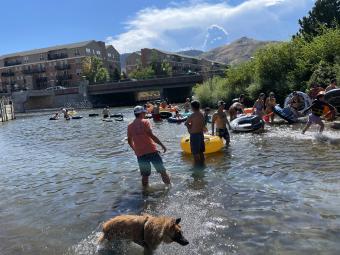Mines study finds high periods of recreational activity on Clear Creek leaves traces of human-connected chemicals
Research conducted over the 2022 Labor Day weekend found substances, like shampoo, makeup and moisturizer, in the creek’s water

Colorado School of Mines researchers, along with colleagues at Johns Hopkins University, conducted a study on the impact of Labor Day-related recreational activity on Clear Creek in Golden, Colorado, and found the holiday festivities left quite a mark on the popular waterway. Fortunately, the study concluded that the impact on Clear Creek quickly dissipated after holiday merrymaking ended.
Assessing the Impact of Recreational Activities on Streams: A Colorado Case Study, published in April 2024 in American Chemical Society ES&T Water, noted that people recreating on Clear Creek during the 2022 Labor Day weekend left traces of what they ingested and topicals they rubbed on their bodies and hair.
While fecal matter and urine were found, makeup and haircare-related substances topped the list of human-connected chemicals found in the creek during the busy holiday period. Traces of body hygiene products and moisturizers came in third and fourth.
“I think what might be surprising to people is that the chemicals we found in Clear Creek are in a mountain stream that people think should be free of these substances,” said James Ranville, professor of chemistry, who conducted the study along with John Spear, professor of civil and environmental engineering, and Carmen Villaruel, PhD student in chemistry. “Literally hundreds of people are crowding into a small stretch of stream. So, the effects are noticeable.”
The measurements made by Carsten Prasse, assistant professor of environmental health and engineering, and PhD student Noor Hamden, both with Johns Hopkins University, determined the presence of organic compounds, but not their concentrations. The Mines researchers documented shifts in the microbial community of the creek. Both are likely transient events associated with recreational use.
Ultimately, the organic compounds will dilute, become environmentally degraded and removed via downstream water treatment plants. Depending on the amount of distance traversed, the microbiota of the creek likely returns to a more natural state, though this was not quantified. Further study is needed to better determine quantities, rates of compound degradation and imposed effects on the riparian corridor plants and animals and overall impact to human health and the environment, Ranville said.
In addition to the human-connected chemicals, research found that tubers and swimmers stirred up metals left over from previous mining activity.
“The stream contains metals like lead, copper and zinc,” Ranville said. “These come from our history of mining in areas like Blackhawk and Central City. Wading kicks up these sediment particles, and although they are not at levels of concern, they are present.”
While the levels of the different chemicals found in the river did not indicate it was unsafe to be in, Ranville said it was advisable not to ingest the creek water. He suggested going easy on topical solutions when recreating in waterways like Clear Creek. Specifically, zinc oxide-based sunscreens are a good choice, he noted.




